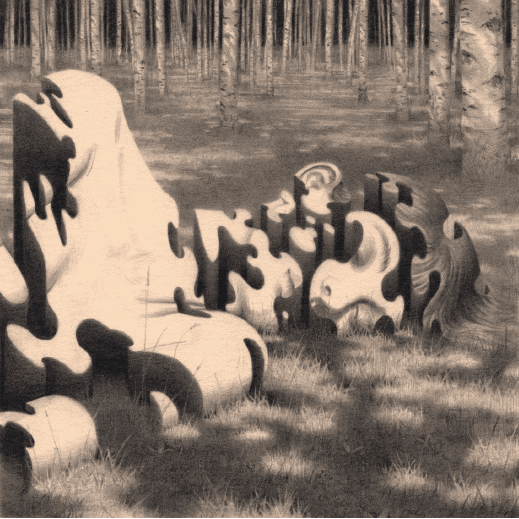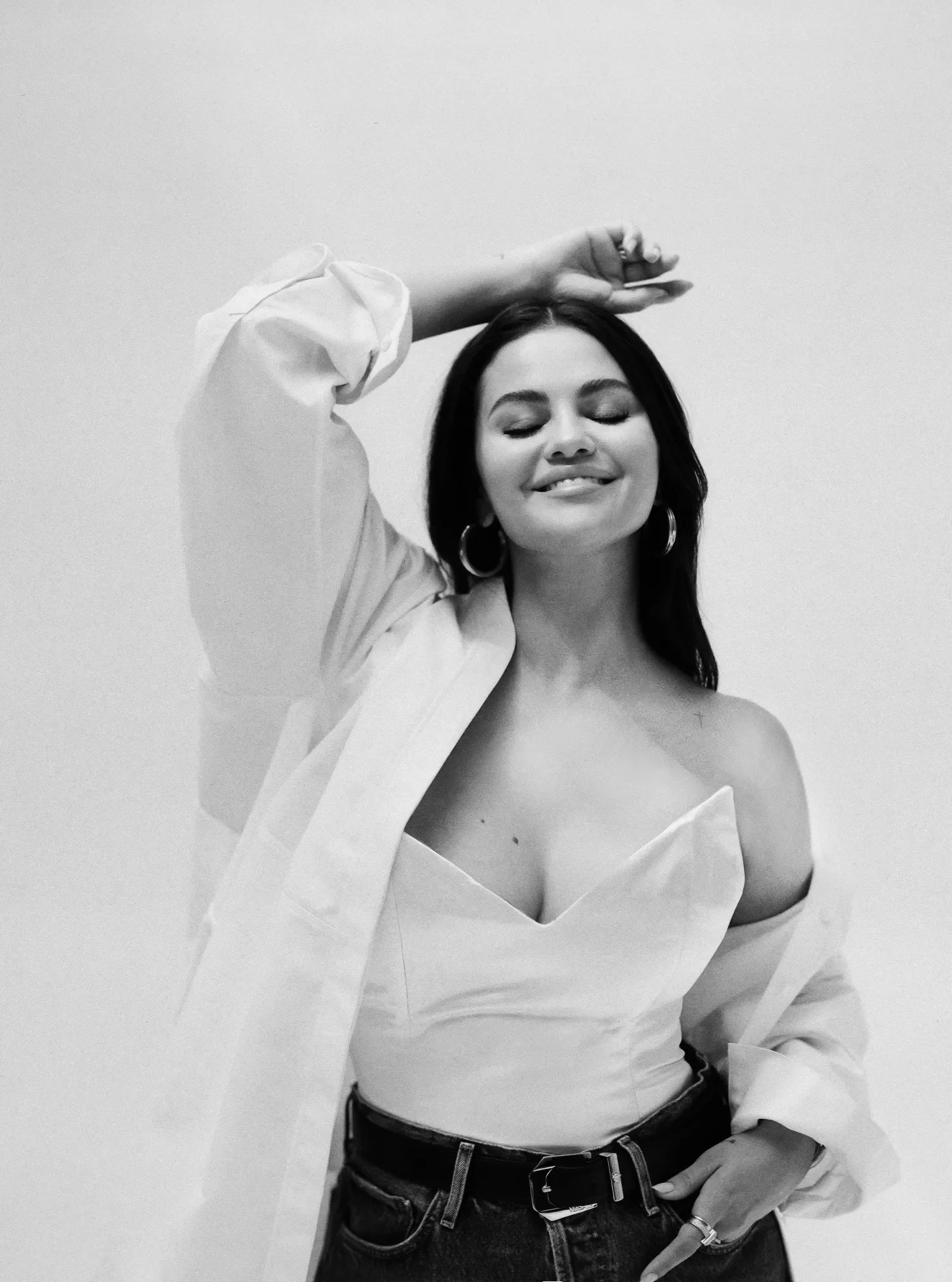The New Luxury: How Kylie Jenner, Selena Gomez, and Jacob Elordi Perfected the 'Parasocial Brand' and Sold the Self as an Object
The "Architecture of Being" as a tangible form. This conceptual work visualizes the core thesis: the 'self' as a deliberately composed, yet fragmented, object—a "living Maison" that can be simulated, curated, and ultimately, sold.
The contemporary subject operates under a new philosophical imperative: "not merely to build a life, but to be its architecture". This "Architecture of Being" philosophy posits that a human existence can be "deliberately composed," resulting in a "living Maison of the self". This "Maison" is furnished not just with physical objects, but with "artifacts for a life," specifically "Post-Luxury Conceptual Functional Art." To acquire such an artifact is to "accept the mantle of stewardship," adding a personal chapter to its narrative.
From a critical perspective, this "art of living" resonates with a documented cultural shift away from "a 'socially integrated' paradigm to a more 'personal or individuated' paradigm," defined by a "focus on self-expressiveness" and a "shift in concern... to interpersonal intimacy". Jean Baudrillard’s critique of consumption provides the mechanism for furnishing this new self: the consumer "no longer relates to a particular object in its specific utility, but to a set of objects in its total signification". Consumers, therefore, "buy into" these significations for the "construction of their self-identities".
This report posits that the Parasocial Brand is the synthesis of these two concepts. The celebrity’s curated persona is the "conceptual art". They are, in Baudrillard's terms, a "simulation of themselves, a hyperreal conjuration" on the "vast screen of the spectacle". As critical theorist Chris Rojek postulates, the celebrity "embodies desire in an animate object," which is a far more efficient resource than inanimate commodities because it "humanize[s] desire".
This marks a fundamental inversion of the 20th-century luxury model. That traditional model, defined by a "shift... to symbolic associations" , used celebrities as endorsers. The primary risk was "celebrity overshadow" —the fear that the celebrity agent would become more significant than the brand principal. In the new model, articulated by the cultural aphorism, "I'm not a businessman. I'm a business, man" , the "overshadow" is the business model. The celebrity is the principal and the brand. The product (e.g., a Kylie Cosmetics lip kit) is now merely the "functional art" , an agent whose sole purpose is to grant the consumer tangible access to the celebrity's "total signification".
Rojek’s "animate object" is the critical-theory explanation for the "conceptual art". Desire is abstract. Where a watch was an inanimate vessel for it, the Parasocial Brand (e.g., Kylie Jenner) is a living vessel. This "living Maison of the self" , turned into a public performance, is the ultimate "conceptual art": "humanized desire" made manifest, packaged, and sold.
A stark illustration of the "living Maison of the self" presented as conceptual art. Tilda Swinton's performance in a glass box powerfully symbolizes the celebrity as a curated, animate object—a public spectacle that embodies "humanized desire" and is packaged for consumption.
The Mechanism of Acquisition: From Parasocial Intimacy to Purchase Intent
The engine of the Parasocial Brand is the Parasocial Relationship (PSR). This psychological mechanism, first identified in the 1950s, has been amplified by new media into the dominant commercial force in the attention economy.
Engineering Intimacy: The Architecture of the PSR
PSRs, first conceptualized by Horton & Wohl (1956) , are "unidirectional connections" and "nonreciprocal socio-emotional connections". They are defined by an "illusion of intimacy" and "illusions of friendship" that audiences develop with media figures.
While traditionally studied with television characters , social media platforms have accelerated PSRs to a "much larger scale". Social media provides "more opportunities for intimate, reciprocal, and frequent interactions". Features such as "direct messaging and story interactions" actively blur "the boundaries between mediated interactions and in-person relationships". This technology fortifies the "illusion of reciprocity" , even when, as researchers note, "almost no true exchange" occurs between the fan and the celebrity.
This "perceived intimacy" is not accidental; it is engineered through deliberate strategies. Key tools of this construction include:
Strategic Self-Disclosure
The celebrity "divulging personal information" through "behind-the-scenes content or candid posts" fosters the PSR, mirroring the same function self-disclosure serves in intensifying face-to-face relationships.
Perceived Attractiveness
Both "physical or social attractiveness" are consistently identified as "one of the most important factors in building a parasocial connection".
Calculated Authenticity
This is the most critical and nuanced mechanism. Influencers employ "strategic intimacy" , "calculated authenticity," "curated imperfection," and "aspirational ordinariness". They must navigate the "authenticity bind", the need to balance "promotional type posts" with posts that "reveal more of the influencers' personality".
This suggests a paradox: the performance of authenticity has become more vital than actual authenticity, a concept explored through the lens of market collapse in "Anatomy of a Collapse." This is supported by a 2024 study which, contrary to expectations, found that audiences perceived mainstream celebrities as more intimate and reciprocal than micro-celebrities. This implies that mainstream celebrities, as global brands, are simply better at the performance of authenticity. The same study made a crucial discovery: "perceptions of authenticity did not predict greater parasocial interaction," whereas "perceptions of reciprocity and intimacy" did. The goal of the Parasocial Brand, therefore, is not to be authentic, but to perform intimacy so skillfully that it is perceived as authentic, thereby generating the necessary emotional bond.
Intimacy as Credibility & Commerce
The PSR is the "critical mechanism for explaining the persuasive power of influencer marketing". As influencers cultivate the role of "pseudo-friends" , they "wield substantial influence over their followers' purchasing decisions".
Academic literature reveals a clear, multi-step commercial pathway. First, Influencer Credibility—a composite of trustworthiness, expertise, attractiveness, and homophily (perceived similarity) —is shown to strengthen the PSR. Second, a strong PSR enhances Source Trustworthiness and Brand Credibility. Finally, this resulting Brand Credibility "positively influences" the end-goal: Purchase Intention.
Beyond this mediated path, studies also confirm that PSRs directly enhance purchase intention. This effect is most potent for "low-involvement products, where emotional appeals are more effective than rational evaluations". This finding is the key to the Parasocial Brand's commercial model. It functions by using a low-cost, "low-involvement product" (a $20 lipstick) as the simple transactional vehicle for a high-cost, high-involvement emotional object (the celebrity's self). The consumer is making an emotionally high-involvement decision to acquire a piece of the "conceptual art," but the financial transaction is disguised as a rationally low-involvement purchase.
A 2024 study which found that PSR had no significant direct effect on Purchase Intention, at first, appears to contradict this model. However, a deeper analysis shows it perfects the thesis. That study did find that PSR builds "Luxury Brand Value Perception," and that this perception in turn affects "Purchase Intention". This is the thesis precisely: the celebrity is the luxury object. The PSR's function is not to sell a product. Its function is to build the perceived luxury value of the celebrity's self. Once the celebrity-as-brand is perceived as a luxury object, that perception drives the purchase of the associated "functional art".
The Consumer as Curator: Self-Extension and the Digital Object
The consumer in this model is not a passive recipient but an active curator, engaging in a continuous process of relational maintenance and identity construction.
The Search as Relational Maintenance
Digital consumer behavior is an active process of "searching for items, comparing alternatives, selecting or acquiring". The search queries that define this study (e.g., "Kylie Jenner," "Jacob Elordi") are this act in practice. PSRs function similarly to interpersonal friendships and require "relational maintenance".
In the pre-digital era, this maintenance was the "weekly viewings of Keeping Up with the Kardashians". In the digital age, this maintenance is the search. It is "surveillance" and "information-seeking" , which "blogs and social media sites... increase the ease" of. The search query is not a neutral act of information gathering; it is the first step in acquisition. It is a "computer-mediated mass relational maintenance" behavior that reinforces the PSR. This act builds the brand credibility necessary for the eventual commercial transaction. The search is the psychological prerequisite for the purchase, the initial act of "stewardship" over the chosen parasocial artifact.
Consumption as Self-Extension and Psychological Ownership
Digitalization has "centered the consumer self-concept". It is a foundational concept in consumer research that individuals "construct their self-concepts and... personal identities" through consumption. An object, when consumed, "can actively contribute to the construction of the consumer's identity through self-expansion and self-extension experiences".
Consumers "appropriate the symbolic meanings of brands" and "give technical objects subjective meanings (projections, associations)". In the Parasocial Brand model, the celebrity's "persona narratives... form the celebrity's brand" , and these symbolic meanings are transferred to the products. The consumer then purchases the product to "maintain, extend and enhance their ideal selves" , effectively bridging the gap between their "real and ideal selves".
This process culminates in Psychological Ownership (PO). Studies confirm that celebrity endorsement is a direct antecedent to PO , which in turn "positively predicted... brand loyalty". The purchase of the "functional art" (e.g., Rare Beauty blush) is the act that physicalizes the digitally-formed PSR. The consumer self is now a "hybrid self-concept" , existing online as a "follower" and offline. The purchase of the product creates a "phygital" object that allows the consumer to physically manifest their digital relationship. By applying the makeup, the consumer performs a "consumption ritual" that allows them to "self-extend" and appropriate the "conceptual art" (the celebrity's persona) onto their own body. This final act solidifies the "psychological ownership" of the brand's meaning, successfully furnishing their "living Maison of the self" .
Case Studies in Parasocial Architecture: Modalities of the Celebrity Object
These three figures represent the primary modalities of the Parasocial Brand. Each has perfected a unique strategy for commodifying their 'living Maison of the self.' Click any image for a detailed analysis of their specific parasocial architecture.
The cluster of celebrities analyzed reveals not a monolithic phenomenon, but a series of distinct modalities for constructing the self as a luxury object. Each strategy builds a different kind of parasocial bond, offering the consumer a different form of symbolic meaning to acquire.
Kylie Jenner employs a strategy of Aspirational Commodification. Her core PSR mechanism is built on perceived friendship, intimacy, and exclusivity. The key consumer "acquisition" is her glamour, lifestyle appeal, and the "thrill of recognition". This model's primary vulnerability is an authenticity crisis, such as the Forbes scandal , or market saturation.
Selena Gomez utilizes Vulnerable Authenticity. This strategy is rooted in shared values, empathy, and a clear social mission. Consumers acquire inclusivity, self-acceptance, and a sense of moral "goodness". The fracture point here, though low-risk, would be any perceived inauthenticity of that mission.
Kendall Jenner's modality is Aloof Curation (High-Fashion). She uses aspirational status and aesthetic consistency to build her brand. The consumer, in turn, acquires her "taste," high-fashion status, and curatorial eye. Her vulnerability is the perception of "fakeness" or a lack of the intimacy her peers provide.
Jacob Elordi represents The Performative Male Object. His mechanism is an aspirational, "art-house" persona. Consumers acquire niche status, the ability to signal their own "taste" , and a form of male objectification. This brand risks collapse if the persona fails or the curation no longer "signals" correctly.
Jojo Siwa demonstrates a Parasocial Bond Break. The mechanism was an expectancy violation stemming from an inauthentic rebrand. This resulted in the bond breaking and a rejection of the new persona. The fracture point was a betrayal of her core audience and a perception of inauthenticity.
Finally, Madison Beer illustrates Pathological Parasociality. Her brand was built on intense intimacy, with fans feeling they "grew up with" her. This bond was weaponized, leading to fan entitlement and a perceived ownership of the star. The vulnerability is the inevitable breach of this perceived reciprocity.
The Archetype: Kylie Jenner and Aspirational Commodification
A prime example of "Aspirational Commodification." In this holiday campaign, Kylie Jenner's persona is perfectly "intimately associated" with the product. The scene manufactures a "perception of intimacy" and "lifestyle appeal," framing the product as a tangible piece of her curated, aspirational world. This is not a simple endorsement; it is the "union of ethos, pathos, and visual design" that defines the Parasocial Brand.
Kylie Jenner represents the perfection of the Parasocial Brand. Her brand's performance is "intimately associated" with her persona. She "pioneered" a model that leverages her "massive social media following" to "build trust". Her strategy is a masterclass in "calculated authenticity" , employing "authentic promotion" , "authentic storytelling" , and "behind-the-scenes content" to manufacture a "perception of intimacy". A key tactic is reposting "user-generated content" , which gives fans the "thrill of being recognized". This provides the "perceived reciprocity" that deepens the PSR. The consumer acquires a piece of her "lifestyle appeal" ; her brand is the "union of ethos, pathos, and visual design" that "expertly integrates personal identity with product promotion". This model was previously validated in a study on Kim Kardashian, which confirmed PSI as a potent "advertising vehicle".
The Antithesis: Selena Gomez and the Vulnerability Value Proposition
The "Vulnerability Value Proposition" in practice. In stark contrast to aspirational models, Selena Gomez's brand is built on shared values and self-acceptance. This moment is not a performance of glamour but an act of connection. By reframing her brand as a "movement" rooted in mental well-being, the purchase of a product is no longer an act of social climbing, but a moral act of "social responsibility" and "strong personal connection."
Selena Gomez's Rare Beauty presents a strategic counter-model, leveraging vulnerability to build a PSR that is perceived as more inclusive and resilient. Rare Beauty is positioned not as a brand, but as a "movement" rooted in Gomez's "personal experiences with mental health". Its mission rejects aspiration ("not about being someone else") in favor of self-acceptance ("being who you are").
The PSR is built on "authentic storytelling" , "Gomez's personal engagement" , and a "commitment to inclusion and mental health". The Rare Impact Fund, which pledges 1% of all sales to mental health initiatives , is the brand's core. This reframes the purchase as a moral act of "social responsibility". This "vulnerability value proposition" creates a "strong personal connection" rooted in shared values, not social climbing. This makes Gomez's model structurally more defensible. Kylie's aspirational brand is fragile; her "billionaire" status, a key part of the performance, was "stripped" by Forbes. Gomez's brand is rooted in an emotional promise (mental well-being) , not a material one. This explains why Rare Beauty, with its "beautiful positive message," is "surpassing" Kylie Cosmetics, which is perceived as "just Kylie Jenner". This aligns with the principles outlined in "Value Beyond Price."
The Exception: Kendall Jenner and the Brand of Aloofness
The architecture of "Aloof Curation." This high-fashion portrait demonstrates a brand built not on "friendly" intimacy, but on the power of "Influencer Consistency" and aesthetic status. Kendall Jenner's brand is "aloof" and "selective," making her curatorial eye the "conceptual art" that consumers seek to acquire.
Kendall Jenner demonstrates a crucial exception: a PSR can be maintained not through "friendly" intimacy but through the consistent curation of high-fashion status. She is a "muse" for "premium," "luxury" brands , and her brand is "aloof" and "selective" , not "approachable". A 2024 study found her PSR is maintained through "Influencer Consistency." Her followers are not seeking friendship; they are seeking taste. As one fan reported, "since I'm really into fashion, I would always like to look more into her outfits". Her power is such that a simple "tank top" becomes a "polarizing fashion conversation". The consumer acquires her eye—her aesthetic curation is the "conceptual art" , and the Alo Yoga set or "dupes" of the tank top are the "functional art" used to furnish their "Maison" with her status. This mirrors the "architecture of influence" seen in figures like Hiroshi Fujiwara.
The Male Object: Jacob Elordi and the Performative Self
The "Performative Male Object" in motion. In this Bottega Veneta campaign, Jacob Elordi is the "conceptual art" that activates the "functional art"—the bag. His persona is curated through these accessories, which "double as personality cues" and "signal his taste." The consumer acquires the bag to appropriate his "art-house" status, making the purchase an act of relational maintenance and self-extension.
Jacob Elordi exemplifies the male Parasocial Brand, where the "self" is a "performative" object curated through his association with other luxury objects. He is the "conceptual art" that activates the "functional art" (his accessories). He is known as the "Bottega bag king". His "bags double as personality cues" ; he "signals his taste" by carrying specific bags or being seen with niche books —a direct application of Bourdieu's Distinction.
This curation makes him "relatable yet aspirational". Crucially, his own public discussion of his "frustrating" "objectification" becomes part of the performance. He is a "simulation" (Baudrillard) of an "art-house" film star, and his critique of his objectification only adds value to that simulation, making it appear more "deep" and "authentic". He is the "conceptual art" and knows it. The consumer's "acquisition" is twofold: first, the search (relational maintenance) to observe his curation , and second, the purchase of the same objects (the Bottega Andiamo) to appropriate his status.
The Fracture Point: Jojo Siwa and the Parasocial Bond Break
A visual case study of a "Parasocial Bond Break." The image on the left represents the "wholesome" brand built on the "Jojo Bow," an object that signified empowerment to a specific audience. The image on the right, from her "Karma" rebrand, represents a direct "expectancy violation." This "extreme... switch" was rejected by her audience as "forced and in-genuine," proving their "psychological ownership" of the original brand and the severe consequences of betraying a parasocial contract.
Jojo Siwa's "Karma" rebrand is a catastrophic failure that perfectly illustrates "expectancy violation". Her original brand was "wholesome" , built on a single, powerful object: the "Jojo Bow" , which signified "empowerment" and an "exclusive mother-daughter bond". This built a powerful, long-term PSR. The "extreme... switch" to a "bad girl" image was rejected by her audience as "forced and insincere" , "cringy and in-genuine". Unlike Miley Cyrus's gradual, "thought out transition" , Siwa's was inauthentic. This "perceived departure" was a direct "expectancy violation" —a breach of the PSR contract. The audience, who felt they were "stewards" of the "Jojo" brand, felt "betrayed". The failure proves the audience's "psychological ownership" of the celebrity-object.
The Parasocial Price: Madison Beer and Weaponized Entitlement
The "Pathological Parasociality" performed. This image, a still from a music video, is a meta-commentary on the "fan entitlement" that defines Beer's brand. By cultivating an intense PSR where fans "grew up with" her, the "normalization of intimate sharing" creates "unfair expectations" and "psychological ownership." This simulated media scrum, complete with a chyron demanding to know her real feelings, perfectly illustrates the dangerous endgame of the Parasocial Brand: the consumer believes they own the celebrity-object.
Madison Beer's career illustrates the pathological endgame of the Parasocial Brand. As a "child of the digital age" who "grew up with" her fans , she cultivated an intense PSR. This "normalization of intimate sharing" creates "unfair expectations". Fans "feel entitled to emotionally attach themselves" and expect the "perceived bond" to be "reciprocated".
This "fan entitlement" is the logical, pathological conclusion of the Parasocial Brand's core premise. The brand intentionally "blurs boundaries" to foster "psychological ownership" and drive sales. When the celebrity (Beer) acts as an autonomous human rather than the "object" the fan "acquired," the fan perceives this as a breach of the parasocial contract. The resulting "stalking or harassment" is a an attempt to control their "property." This is the ultimate danger of becoming the luxury object: the consumer believes they own you.
The Self as the Final Luxury
The "hyperreal" (Baudrillard) as the final landscape. In this saturated world of simulations, the "sign becomes an object again... a fetish." The Parasocial Brand is the ultimate expression of this, where the "object of affection" is no longer a physical thing, but the "deliberately composed" simulation of another's self.
The analysis of this celebrity cluster confirms the perfection of the Parasocial Brand. The psychological mechanism (PSR -> Credibility -> Purchase) and the consumer's motivation (Self-Extension -> Psychological Ownership) are empirically established. The case studies have illustrated the modalities of this phenomenon: Kylie's Aspiration , Selena's Vulnerability , Kendall's Aloofness , and Jacob's Performative Objectification. The failures of Jojo Siwa and Madison Beer reinforce the model by showing the severe consequences of violating this parasocial contract.
This confirms a shift into what Baudrillard termed the "hyperreal". The Parasocial Brand is not a person. It is a "simulation of themselves" , a "sign [that] becomes an object again... a fetish". This "animate object" is simply the most efficient vessel for "humaniz[ing] desire" in the contemporary attention economy.
We return, finally, to the "Architecture of Being". The highest philosophical aim is "to inhabit an existence so deliberately composed that one's very being becomes a testament to the art of living". The Parasocial Brand is the industrialization of this philosophy. The celebrities analyzed have successfully commodified their "deliberately composed" existence as "conceptual art." The consumer, in turn, engages in "relational maintenance" and "digital acquisition" to acquire the "functional art" (the products). They purchase these artifacts to furnish their own "living Maison of the self" with the meaning and signification of the celebrity's simulated life. The Parasocial Brand is the final luxury, where the "object of affection" (PLCFA Definition) is no longer a thing, but the self of another.
Authored by Christopher Banks, Anthropologist of Luxury & Critical Theorist. Office of Critical Theory & Curatorial Strategy, Objects of Affection Collection.












